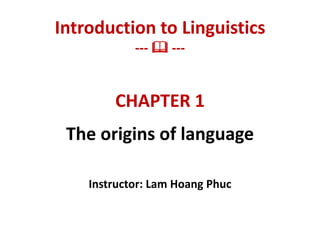Chapter 1.pptx
•Download as PPTX, PDF•
0 likes•57 views
The origins of language
Report
Share
Report
Share

Recommended
Recommended
More Related Content
What's hot
What's hot (20)
Introduction to Linguistics_2 Linguistics, Language and the Origin of Languag...

Introduction to Linguistics_2 Linguistics, Language and the Origin of Languag...
Similar to Chapter 1.pptx
Similar to Chapter 1.pptx (20)
ELS102_English Language and Laguage Acquisition .pptx

ELS102_English Language and Laguage Acquisition .pptx
originoflanguage-141112084018-conversion-gate01 (1) 3.pdf

originoflanguage-141112084018-conversion-gate01 (1) 3.pdf
Recently uploaded
God is a creative God Gen 1:1. All that He created was “good”, could also be translated “beautiful”. God created man in His own image Gen 1:27. Maths helps us discover the beauty that God has created in His world and, in turn, create beautiful designs to serve and enrich the lives of others.
Explore beautiful and ugly buildings. Mathematics helps us create beautiful d...

Explore beautiful and ugly buildings. Mathematics helps us create beautiful d...christianmathematics
Recently uploaded (20)
Explore beautiful and ugly buildings. Mathematics helps us create beautiful d...

Explore beautiful and ugly buildings. Mathematics helps us create beautiful d...
ICT Role in 21st Century Education & its Challenges.pptx

ICT Role in 21st Century Education & its Challenges.pptx
Jual Obat Aborsi Hongkong ( Asli No.1 ) 085657271886 Obat Penggugur Kandungan...

Jual Obat Aborsi Hongkong ( Asli No.1 ) 085657271886 Obat Penggugur Kandungan...
Basic Civil Engineering first year Notes- Chapter 4 Building.pptx

Basic Civil Engineering first year Notes- Chapter 4 Building.pptx
ICT role in 21st century education and it's challenges.

ICT role in 21st century education and it's challenges.
Micro-Scholarship, What it is, How can it help me.pdf

Micro-Scholarship, What it is, How can it help me.pdf
Kodo Millet PPT made by Ghanshyam bairwa college of Agriculture kumher bhara...

Kodo Millet PPT made by Ghanshyam bairwa college of Agriculture kumher bhara...
HMCS Max Bernays Pre-Deployment Brief (May 2024).pptx

HMCS Max Bernays Pre-Deployment Brief (May 2024).pptx
Vishram Singh - Textbook of Anatomy Upper Limb and Thorax.. Volume 1 (1).pdf

Vishram Singh - Textbook of Anatomy Upper Limb and Thorax.. Volume 1 (1).pdf
Chapter 1.pptx
- 1. CHAPTER 1 The origins of language Instructor: Lam Hoang Phuc Introduction to Linguistics --- ---
- 2. A divine entity provides humans with language. Infants growing up without hearing any language around them will use the original God-given language. Psammetichus’ experiment: Two infants living with goats uttered something similar to a Phrygian word. Phrygian might be the original language; however, the infants probably just mimicked the goats. King James’ experiment: Children living in isolation spoke Hebrew. Hebrew might be the original language; however, other cases do not confirm this – infants without access to human language in their early years normally produce no language at all It is impossible to reconstruct the original language. 1.1. The divine source
- 3. 1.2. The natural sound source “bow-wow” theory: Primitive words could have been imitations of natural sounds. All modern languages have words whose pronunciations echo natural sounds (onomatopeia). However, this view cannot be applied to soundless things and abstract concepts. The original sounds of language may have come from natural cries of emotion. However, these expressive noises contain sounds that are not used in ordinary talk.
- 4. 1.3. The social interaction source “yo-he-ho” theory: Language could have come from the sounds of people involved in physical effort such as hums, grunts, groans and curses. This theory places the development of human language in a social context. However, other primates live in social groups and use grunts and social calls, but they do not seem to have developed the capacity for speech. This theory does not point out the origin of language.
- 5. 1.4. The physical adaptation source The evolutionary process of humans created certain physical features which appear to be relevant for speech production: o upright teeth. o flexible lips with much more intricate muscle interlacing than other primates. o small mouth that can be opened and closed rapidly. o smaller, thicker, and more muscular tongue. o larynx at a lower position. creating a longer cavity called the pharynx. These features allow a more rapid and powerful delivery of a larger range of sounds despite some disadvantages (e.g. prone to food choking).
- 6. 1.5. The tool-making source The functions that control the motor movements involved in complex vocalization (speaking) and object manipulation (making or using tools) are very close to each other in the left hemisphere of the brain. There may have been an evolutionary connection between language-using and tool-using abilities, i.e. when humans developed the ability to craft and use tools, they also developed the ability to produce speech. Combining rocks to build a tool is comparable to combining sounds to build a complex message.
- 7. 1.6. The genetic source innateness hypothesis: Only human offspring are born with a special capacity for language. Language capacity is genetically hard-wired in the newborn human. Evidence: o Human infants develop physical features needed for the production of speech in a relatively short period of time. Possible genetic mutation. o The complexity of the young child’s language. o Children who are born deaf can become fluent sign language users.
- 8. REFERENCES Yule, G. (2010). The study of language (4th ed.). Cambridge: Cambridge University Press.